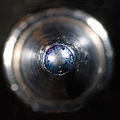Wikijunior:How Things Are Made/Chemical/Ballpoint Pen
Products
[edit | edit source]-
A ballpoint pen
-
Closeup of ballpoint pen writing on paper surface
-
Macro photo of the ballpoint tip
A ballpoint pen is a writing instrument which features a tip that is automatically refreshed with ink. It consists of a precisely formed metal ball seated in a socket below a reservoir of ink. As the pen is moved along a writing surface, ink is delivered. Now, ballpoint pens dominate the writing instrument market, selling over one hundred million pens each year worldwide.
What do we need to make this thing?
[edit | edit source]Metals, plastics, and other chemicals are used for making the components of a ballpoint pen.
That ball at the end of the point is made of textured tungsten carbide ball. This material is selected because it is particularly resistant to deforming and designed to be a perfect sphere that can literally grip most any writing surface. The pits are connected by a series of channels that are continuous throughout the entire sphere.
The points of most ballpoint pens are made out of brass, which is an alloy of copper and zinc. This material is used because of its strength, resistance to corrosion, appealing appearance, and ability to be easily formed. However, plastics have become an important raw material in ballpoint pen manufacturer. They have the advantage of being easily formed, lightweight, corrosion resistant, and inexpensive. They are primarily used to form the body of the pen, but are also used to make the ink cartridge, the push button, the cap.
The ink can be specially made by the pen manufacturer. To be useful in a ballpoint pen, the ink must be slightly thick, slow drying in the reservoir, and free of particles. These characteristics ensure that the ink continues to flow to the paper without clogging the ball. When the ink is on the paper, rapid drying occurs via penetration and some evaporation. In an ink formulation, various pigments and dyes are used to provide the color. Other materials, such as lubricants, surfactants, thickeners, and preservatives, are also incorporated. These ingredients are typically dispersed in materials such as oleic acid, castor oil, or a sulfonamide plasticizer.
Polypropylene copolymer (PPC) is used to make the barrel and cap on plastic pens. PPC is both lightweight and sturdy.
What is the step by step process?
[edit | edit source]- Step 1: Workers known as compounders follow formula instructions to make batches of ink in a designated area of the manufacturing plant. Raw materials are poured into the batch tank and thoroughly mixed. Depending on the formula, these batches can be heated and cooled as necessary to help the raw materials combine more quickly. Some of the larger quantity raw materials are pumped and metered directly into the batch tank. These materials are added simply by pressing a button on computerized controls. These controls also regulate the mixing speeds and the heating and cooling rates.
- Step 2: The metallic components of the pen are being constructed while the ink is being made. The tungsten carbide balls are typically supplied by outside vendors. Other parts of the pen, such as the point and the body, are made using various injection plastic molds
- Step 3: The plastic components of the pen are constructed simultaneously with the other pen pieces. They can be produced by either extrusion or injection molding.
Straight hollow parts such as barrel and ink reservoir are made by extrusion process which involves a large spiral screw, which forces the material through a heated chamber, making it a thick, flowing mass. It is then forced through a die, cooled, and cut.
More complex shapes parts like caps, ends, and mechanical components used injection molding . In this process the plastic is heated, converting it into a liquid that can then be forcibly injected into a mold. After it cools, it solidifies and maintains its shape after the die is opened.
- Step 4: The tungsten carbide balls are typically supplied by outside vendors. Other parts of the pen, such as the point and the body, are made using various molds. First, bands of brass are automatically inserted into stamping machines, which cut out thousands of small discs. The brass discs are next softened and poured into a compression chamber, which consists of a steel ram and a spring-backed ejector plunger. The steel ram presses on the metal, causing the plunger to retract and forcing the metal into a die cast mold. This compresses the metal and forms the various pen pieces. When the ram and plunger return to their original positions, the excess metal is then scraped off and recycled. The die is then opened, and the pen piece is ejected.
- Step 5: After the components are formed, assembly can take place. Typically, the ballpoint is first attached to the ink reservoir. These pieces are then conveyored to injectors, which fill the reservoir with the appropriately colored ink. If a spring is going to be present, it is then placed on the barrel of the reservoir.
- Step 6: The point and reservoir are then placed inside the main body of the pen. At this stage, other components such as the cap and ends are incorporated.
- Step 7: The finished pens are then packaged according to how they will be sold. Single pens can be put into blister packages with cardboard backings. Groups of pens are packed into bags or boxes. These sales units are then put into boxes, stacked on pallets, and shipped to distributors.
-
Step 1: Compounding the inks from different materials
-
Step 2: Extrusion Process for simple plastic parts
-
Step 5: Video shows ink are consistently refilled





